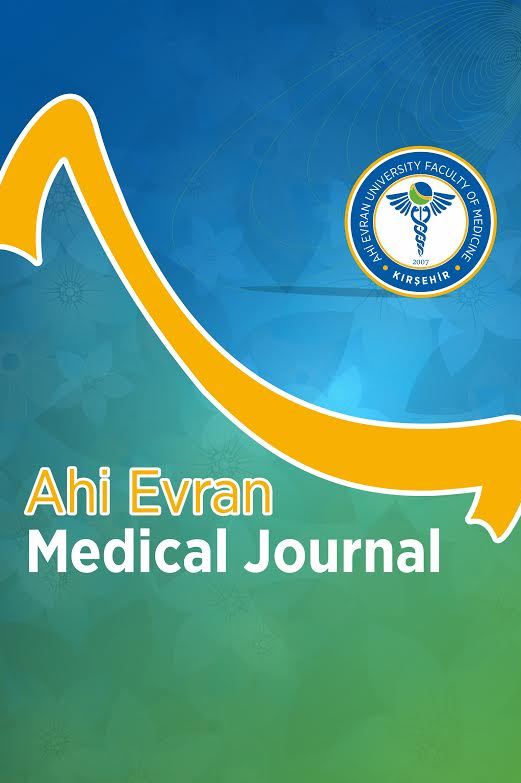Vaka ve Ölüm Sayılarının Kısa Dönem Tahmini için Resmi Kaynaklardan COVID-19 Veri Takibinin Önemi
COVID-19, ARIMA, Brown’s LES, Holt’s LES, tahmin
Importance of Tracking COVID-19 Data from Official Sources for Short-Term Forecasting of Cases and Deaths
COVID-19, ARIMA, Brown’s LES, Holt’s LES, forecasting,
___
- 1. Liu YC, Kuo RL, SR Shih. COVID-19: The first documented coronavirus pandemic in history. Biomed J. 2020;43(4):328-333.
- 2. Reintjes R, Das E, Klemm C, Jan Hendrik Richardus JH, Keßler V, Ahmad A. "Pandemic Public Health Paradox": Time Series Analysis of the 2009/10 Influenza A / H1N1 Epidemiology, Media Attention, Risk Perception and Public Reactions in 5 European Countries. PLoS One. 2016;11(3):e0151258.
- 3. Chintalapudi N, Battineni G, F Amenta. COVID-19 virus outbreak forecasting of registered and recovered cases after sixty day lockdown in Italy: A data driven model approach. J Microbiol Immunol Infect. 2020;53 (3):396-403.
- 4. Yousaf M, Zahir S, Riaz M, Hussain SM, Shan K. Statistical analysis of forecasting COVID-19 for upcoming month in Pakistan. Chaos Solitons Fractals. 2020;138:109926.
- 5. Roosa K, Lee Y, Luo R, et al. Real-time forecasts of the COVID-19 epidemic in China from February 5th to February 24th, 2020. Infect Dis Model. 2020;5:256-263.
- 6. Li Q, W Feng, ve Quan YH. Trend and forecasting of the COVID-19 outbreak in China. J Infect. 2020;80(4):469-496.
- 7. Fanelli D, Piazza F. Analysis and forecast of COVID-19 spreading in China, Italy and France. Chaos Solitons Fractals. 2020;134:109761.
- 8. Mohammed AAA, Ahmed AE, Hong F, Mohamed AEA. Optimization Method for Forecasting Confirmed Cases of COVID-19 in China. J Clin Med. 2020;9(3):674.
- 9. Wu JT, Leung K, Leung GM. Nowcasting and forecasting the potential domestic and international spread of the 2019-nCoV outbreak originating in Wuhan, China: a modelling study. Lancet. 2020;395(10225):689-697.
- 10. Xiaorong W, Qiong Z, He Y, et al. Nosocomial outbreak of COVID-19 pneumonia in Wuhan, China. Eur Respir J. 2020;55(6).
- 11. Papastefanopoulos V, Linardatos P, Kotsiantis S. COVID-19: A Comparison of Time Series Methods to Forecast Percentage of Active Cases per Population. Applied Sciences. 2020;10(11):3880.
- 12. Gothai E, Thamilselvan R, Rajalaxmi RR, Sadana RM, Ragavi A, Sakthivel R. Prediction of COVID-19 growth and trend using machine learning approach. Mater Today Proc. 2021;15.
- 13. Ayinde K., Adewale FL, Rauf IR, et al. Modeling Nigerian Covid-19 cases: A comparative analysis of models and estimators. Chaos Solitons Fractals. 2020;138:109911.
- 14. Riley RD, Snell KIE, Ensor J, et al. Minimum sample size for developing a multivariable prediction model: Part I - Continuous outcomes. Stat Med. 2019;38(7): 1262-1275.
- 15. Petropoulos F, Makridakis S. Forecasting the novel coronavirus COVID-19. PLoS One. 2020;15(3): e0231236.
- 16. Cleo A, Lucia R, Athanasios T, Constantinos S. Data-based analysis, modelling and forecasting of the COVID-19 outbreak. PLoS One. 2020;15(3):e0230405.
- 17. Heus P, Johanna AAGD, Romin P, et al. Uniformity in measuring adherence to reporting guidelines: the example of TRIPOD for assessing completeness of reporting of prediction model studies. BMJ Open. 2019;9(4):e025611.
- 18. Allard, R. Use of time-series analysis in infectious disease surveillance. Bull World Health Organ. 1998;76(4):327-333.
- Yayın Aralığı: Yılda 3 Sayı
- Başlangıç: 2017
- Yayıncı: Kırşehir Ahi Evran Üniversitesi
Cemal ÇİÇEK, Altan AKINEDEN, Selçuk TÜRKEL
COVID-19 Hastalarında Antioksidanların ve Oksidatif Hasarın Durumu
İrfan BİNİCİ, Hamit Hakan ALP, Zübeyir HUYUT, Esra GÜRBÜZ, Hülya GÜNBATAR, Şükrü AKMEŞE, Mustafa Kasım KARAHOCAGİL, Halil İbrahim AKBAY
Pandemi Sürecinde Çocukluk Çağı Ev Kazalarının Basın Haberlerine Yansıması
Seda DEMİRCİ, Asya Banu BABAOĞLU
Hemorajik İnmeli Hastalarda Homosistein Düzeyleri
Aysu YETİŞ, Asuman ÇELİKBİLEK, Aysel KAYA TEKEŞİN, Orhan YAĞIZ
Konvansiyonel Fizik Tedavi Alan Fibromiyalji Hastalarında Balneoterapinin Katkısı
Vaka ve Ölüm Sayılarının Kısa Dönem Tahmini için Resmi Kaynaklardan COVID-19 Veri Takibinin Önemi
Kemiksiz Çekiç Parmağın Splintleme ve Perkütan Pinleme Tedavileri: Retrospektif Klinik Çalışma
Selami KARADENİZ, Alparslan YURTBAY
Beyin Ölümü Tanısı Almış Hastaların Optik Sinir Kılıf Çaplarının Retrospektif Olarak İncelenmesi
Merve GÜRSOY DEMİR, Can ÖNER, Huseyin CETİN, Engin Ersin ŞİMŞEK
Sigara İçenlerde Serum Scube-1 Düzeyleri ve Etkileyen Faktörlerin Değerlendirilmesi
